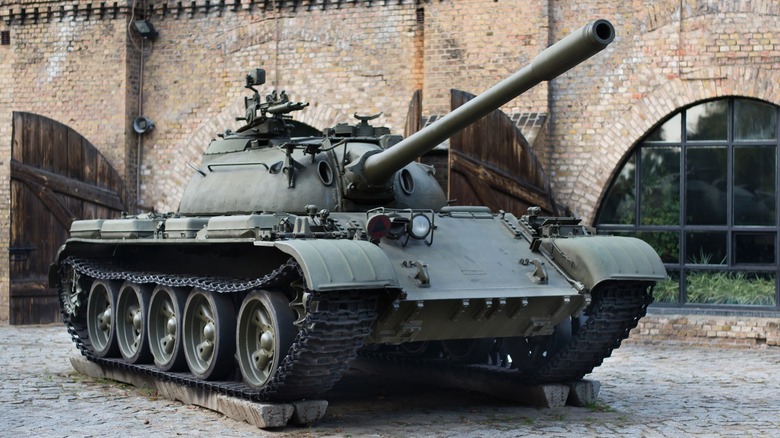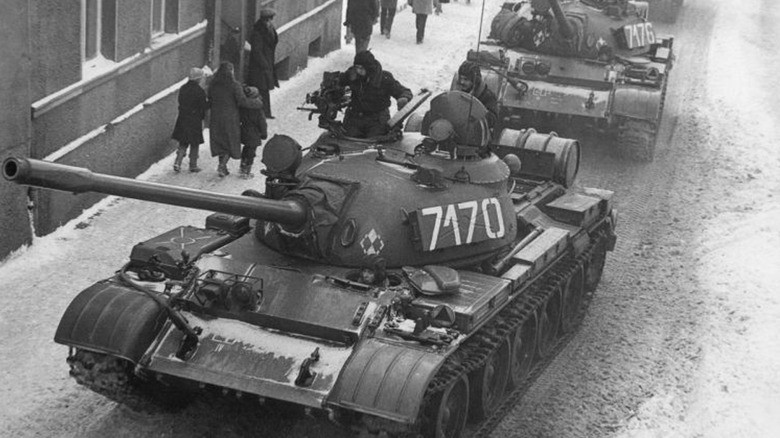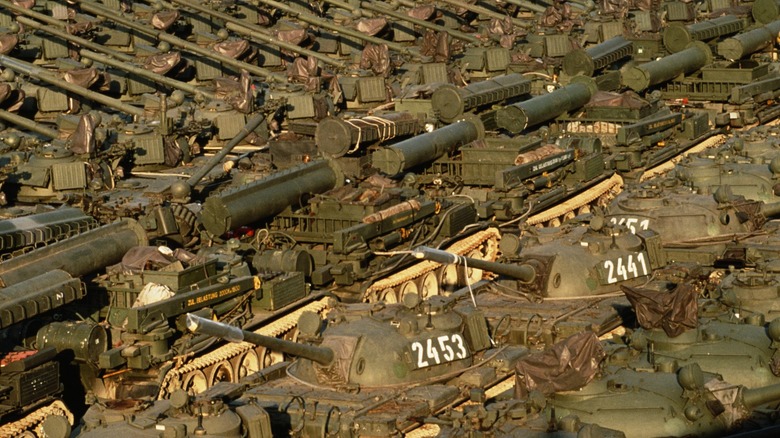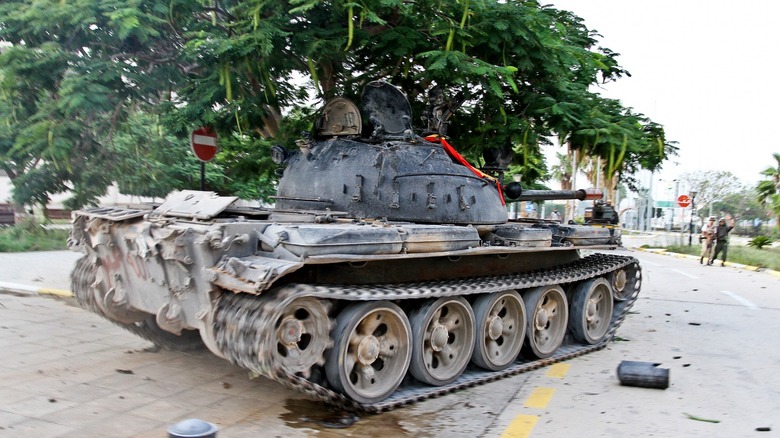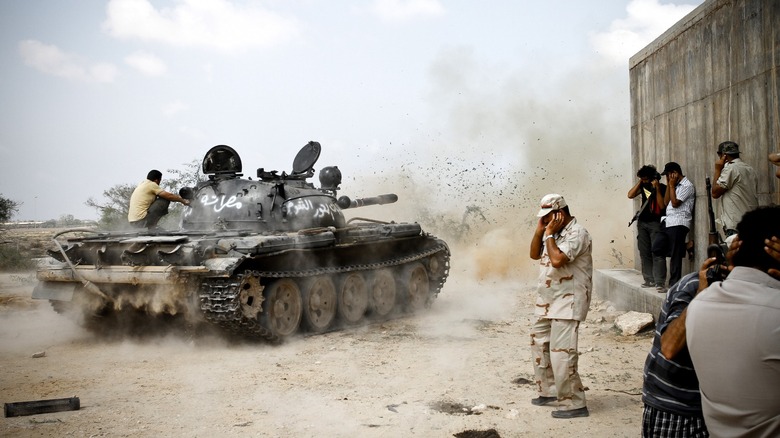Everything To Know About The Soviet T-54/T-55 Tanks
The Second World War was the pinnacle of tank design, with many new looks launched, tested, and deployed in just a few years. By its end, the world had several powerful tanks, like the German Panther and Tiger Tanks, which completely outmatched anything that came out just a decade before.
Nevertheless, the end of the war in 1945 didn't put an end to tank development. Although it was the highly successful T-34 that led the Soviet Union to Berlin, it was outdated by this time. And even though the Soviets developed the T-44 as its successor, it didn't make it to the frontlines.
But, to keep their armor at the forefront, the Soviets decided that the T-44 needed a bigger gun; thus, in 1946, the Red Army adopted the successor of the T-34 and T-44 — the T-54. This tank served as Soviet Russia's primary tank in the immediate post-war period and is the most-produced tank in history.
The first post-war Soviet tank
The T-54 was one of the first post-war Soviet tank designs, alongside the IS-4, which was also produced around the same period. Although the T-62 was the first Soviet main battle tank, the T-54 remained in service long enough for it to get the same designation, with some units seen as recently as Russia's 2022 invasion of Ukraine.
As a post-war tank, the T-54 incorporated all the lessons learned during Russia's drive into Germany. It featured a larger 100mm gun for defeating heavily armored tanks, improved hull and turret armor, a rounded turret that prevented shot traps, and better suspension.
As the T-54 was the primary medium tank — meaning it was more moderately sized than heavy tanks but still packed a hefty punch — the Red Army had thousands of this model in stock and service. According to the U.S. Army, the Soviets made an estimated 86,000 to 100,000 T-54 and T-55 tanks, making it the most-produced tank in history.
[Featured Image by J. Żołnierkiewicz via Wikimedia Commons | Cropped and Scaled | Public Domain]
A tank for the atomic age
Although the T-54 was a good medium tank for its time, scientific advancements and the development of nuclear artillery and portable nuclear weapons like the Davy Crockett system meant that the T-54 needed improvements to face the threat of tactical nukes on the battlefield.
So, to make its tanks resilient against unconventional threats, the Soviets created the PAZ vehicle collective protection system. This system incorporates a radiation detector and an overpressure system to protect the crew from nuclear, chemical, and biological threats. It also hermetically seals the tank once it detects the initial gamma or neutron radiation from a nuclear detonation automatically, protecting the crew even before they have the chance to react.
These improvements, made in 1957, led to the T-55 – an improved variant of the T-54. It also received a more powerful diesel engine and greater range from its additional fuel tanks. It also had a four-round-per-minute rate of fire, slightly better than that of its contemporary heavy tanks.
A Chinese-American T-54/T-55?
When China had a falling out with the Soviet Union, the U.S. built a relationship with it to help counter the Russians. As part of this relationship-building, America offered to develop a main battle tank based on the Chinese Type 59 tank, which is a licensed-built T-54A, in 1988.
This main battle tank was supposed to be called the Jaguar and was an improvement of the Type 59. The U.S. tapped Cadillac Gage to work with the China National Machinery & Equipment Import & Export Corporation to modernize the Type 59 and turn it into the Jaguar MBT.
It was supposed to get the British L7 105mm cannon, a digital fire control system, a night-vision system, and a laser rangefinder. It was also set to receive a more powerful 750hp engine, an automatic transmission system, and spaced armor on top of the Type 59's base protection.
However, the Tiananmen Square Massacre the following year poisoned Chinese-American cooperation, stopping its joint development. Although Cadillac Gage continued development on its own, the fall of the Berlin Wall in late 1989 meant war was over, and no one was interested in the Jaguar.
A budget-friendly main battle tank
Although the T-54/T-55 could arguably be considered a main battle tank, it's still a cheap and simple vehicle to produce. Also, its great production numbers meant that there are many T-54s/T-55s in nations worldwide. And because upgrading a tank is usually cheaper than buying or designing and building a new one, many of its current operators prefer upgrading the T-54/T-55 instead of purchasing a new 2023-model tank.
And because of its lighter armor design coupled with a big 100mm gun, many countries choose to upgrade this tank as its main battle tank instead of buying newer, more expensive models. Upgraded T-54s/T-55s received explosive reactive armor for better protection, the capability to launch anti-tank guided missiles from the gun tube, and a better fire-control system. Some models even received add-on composite armor for increased resistance from enemy fire.
Because of its affordability, many countries still keep the T-54/T-55 in their ranks. Some of these countries include Cuba, Cambodia, Nigeria, and Pakistan. Russia still has some of these tanks in stock and deployed in Ukraine.
The T-55 in Modern Conflicts
Because of its numbers and easy upgradability, the T54/T-55 has faced frontline service in many conflicts since its inception. Its first foray was against the Israelis when the T-54/T-55-equipped coalition of Egypt, Syria, and Jordan was soundly defeated during the Six-Day War. However, this defeat wasn't a knock on the tank's performance but due to Israel's superior planning, tactics, and air cover. It was also used during the Vietnam War when the North Vietnamese Army used it against South Vietnam and the Americans.
India and Pakistan used the T-54/T-55 or the Chinese Type 59 version during their skirmishes in the 70s and 80s. But the latest use of the T-54/T-55 was during the 2022 Russian invasion of Ukraine, where both militaries used old and updated versions of this tank for offensive and defensive operations.
The T-54/T-55 has a storied history. Although we're glad it didn't come to blows with American armor when it first rolled out, it continues showing its firepower on other battlefields. And even if this tank is nearly 80 years old, it still has a place in the armories of many nations today. For as long as someone can find a way to upgrade this tank economically, we can expect it to stay in military service.
